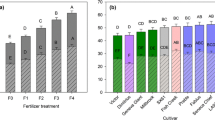Abstract
For decades, seedling peaches have been used as the standard rootstock in California almond orchards. Vigorous, deep rooted trees are needed in almond orchards for maximum yields and to withstand the annual tree-shaking at harvest. Currently, researchers are actively evaluating rootstocks for almonds in field trials and in various screening protocols. In this study, seedling rootstocks, obtained from male-sterile advanced generation peach-almond (PEAL) hybrid mother trees, were compared with ‘Nemaguard’ peach seedlings for emergence in the nursery row, trunk caliper at propagation time, and end of season dormant above ground tree weight. Seedling emergence was affected significantly (P ≤ 0.05) by seed source, as was trunk caliper and end of season dormant above ground tree weight. Trunk caliper and dormant above ground tree weight were also affected significantly (P ≤ 0.05) by planting year. Results obtained in this study demonstrate the enhanced first year growth from seedlings of advanced generation PEAL hybrids, as compared to ‘Nemaguard’ seedlings. Seedling emergence in the rootstock bed was not affected significantly by planting year. Advanced generation PEAL hybrid seedlings were ready for June-budding at an earlier date compared to ‘Nemaguard’ seedlings, providing the potential for larger-sized finished nursery stock by the end of the growing season. Due to the male-sterile status of the advanced generation PEAL mother trees, bloom periods of several root-knot nematode resistant rootstock cultivars were examined for their degree of synchronicity with the mother trees. The examined rootstocks and mother trees varied in both chill hour and post-chill heat requirements necessary to effect bloom. ‘Flordaguard’ peach rootstock began bloom in advance of the male-sterile mother trees, whereas the bloom period of ‘Tsukuba No. 4’ occurred well after, suggesting they would not be effective synchronous pollenizers for consistent hybrid seed production. Based on more limited flowering period data, better bloom synchronicity was achieved with a Tsukuba No. 4 X Flordaguard hybrid.





Similar content being viewed by others
References
Atli HS, Arpaci S, Ayanoglu H (2001) Comparison of seedling characteristics of some Pistacia species. Options Méditerranéennes 56:215–218
Chandler WH (1957) Propagation of deciduous orchard trees. In: Chandler WH (ed) Deciduous orchards, 3rd edn. Lea & Febiger, Philadelphia, PA, pp 209–234
Cesaraccio C, Spano D, Snyder RL, Duce P (2004) Chilling and forcing model to predict bud-burst of crop and forest species. Agric Forest Meteor 126:1–13
Cummins JN, Norton RL (1974) Apple rootstock problems and potentials. NY Food Life Sci Bull 41:1–15
Day LH (1953) Rootstocks for stone fruits. California Agricultural Experiment Station Extension Service, University of California. Bull 736:74
Felipe AJ (1989) Rootstocks for almond. Present situation. Options Méditerranéennes—Série Séminaires 5:13–17
Felipe AJ (1995) Rootstocks for almonds. FAO Nucis Newsl 4:6–9
Guillaumin JJ, Pierson J, Grassely C (1991) The susceptibility to Armillaria mellea of different Prunus species used as stone fruit rootstocks. Sci Hortic 46(1–2):43–55
Jones RW (1969) Selection of intercompatible almond and root-knot nematode resistant peach rootstocks as parents for production of hybrid rootstock seed. J Am Soc Hort Sci 94(2):89–91
Jones RW (1972) Titan, a seed source for F1 almond X Nemaguard peach hybrids. Fruit Var Hort Dig 26(1):18–20
Kains MG (1923) Nursery Management. In: Plant propagation: greenhouse and nursery practice. Orange Judd Publishing Company Inc., New York, NY, pp 268–286
Lockwood D (2000) Peach tree production by Tennessee nurseries. Kentucky Fruit Facts. University of Kentucky, College of Agriculture, Cooperative Extension Service. Jan 2000. http://www.ca.uky.edu/fruitfacts/ffjan01.pdf
McKenry MV, Kretsch J (1987) Survey of nematodes associated with almond production in California. Pl Dis 71:71–73
Okie WR, Beckman TG, Nyczepir AP, Reighard GL, Newall WC, Zehr EI (1994) BY520-9, A peach rootstock for the southeastern United States that increases scion longevity. HortSci 29(6):705–706
Rom RC (1983) The peach rootstock situation: an international perspective. Fruit Var J 37:3–14
Sherman WB, Lyrene PM, Sharp RH (1991) Flordaguard peach rootstock. HortSci 26(4):427–428
Simard MH, Olivier G, Vargas FJ, Romero MA, Gómes Pereira J, Faia de Souza R, Isaakidis A (1997) Sélection de semis de Prunus amygdalus comme porte-greffe de l’amandier. Options Méditerranéennes 16:53–72
Vargas FJ, Romero MA, Clavé J (2001) Trialling of pistachio rootstocks in nursery. Options Méditerranéennes 56:189–195
Weinberger JH, Marth PC, Scott DH (1943) Inheritance study of root knot nematode resistance in certain peach varieties. Proc Am Soc Hort Sci 42:321–325
Wicks TJ (1989) Susceptibility of almond and cherry rootstocks and scions to Phytophthora species. Aust J Expt Agric 29:103–109
Yoshida M, Seike K (1981) Breeding of peach rootstocks resistant to root-knot nematode II. Breeding of resistant rootstocks by hybridization. Bull Fruit Tree Res Stn Ser A 8:31–44
Zalom GG, Goodell PB, Wilson WW, Bentley WJ (1983) Degree-days: the calculation and the use of heat units in pest management. Division of Agriculture and Natural Resources, University of California, Davis, Leaflet No. 21373
Acknowledgments
The authors acknowledge Sherry Peterson for her assistance with data collection and mother tree maintenance throughout the duration of the study. Tom Beckman and Clay Weeks are also acknowledged for their helpful suggestions in the final manuscript preparation.
Author information
Authors and Affiliations
Corresponding author
Rights and permissions
About this article
Cite this article
Ledbetter, C.A., Sisterson, M.S. Advanced generation peach-almond hybrids as seedling rootstocks for almond: first year growth and potential pollenizers for hybrid seed production. Euphytica 160, 259–266 (2008). https://doi.org/10.1007/s10681-007-9569-1
Received:
Accepted:
Published:
Issue Date:
DOI: https://doi.org/10.1007/s10681-007-9569-1




